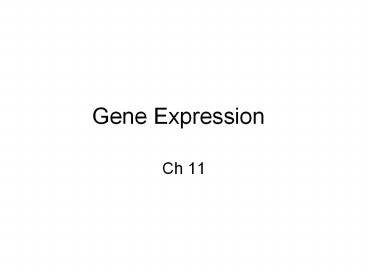Gene Expression - PowerPoint PPT Presentation
1 / 33
Title:
Gene Expression
Description:
Gene Expression Ch 11 Gene expression Genes to proteins Genotype to phenotype Produce specific proteins when and where they are needed lac Operon E. Coli make enzymes ... – PowerPoint PPT presentation
Number of Views:587
Avg rating:3.0/5.0
Title: Gene Expression
1
Gene Expression
- Ch 11
2
Gene expression
- Genes to proteins
- Genotype to phenotype
- Produce specific proteins when and where they are
needed
3
lac Operon
- E. Coli make enzymes to utilize lactose sugars
- Dependent on presence/absence of lactose
- 3 enzymes to take up and metabolize lactose
- Genes that code for enzymes located next to each
other in DNA
4
Fig. 11-1b
OPERON
Regulatory gene
Promoter Operator
Lactose-utilization genes
DNA
mRNA
RNA polymerase cannot attach to promoter
Active repressor
Protein
Operon turned off (lactose absent)
DNA
RNA polymerase bound to promoter
mRNA
Protein
Enzymes for lactose utilization
Inactive repressor
Lactose
Operon turned on (lactose inactivates repressor)
5
lac Operon
- Control sequence
- Promoter
- Operator
- Operon
- Genes, promoter and Operator
- Exist almost solely in prokaryotes
6
lac Operon
- Repressors
- Block RNA polymerase from binding
- Regulatory genes code for repressors
- Located outside the operon
7
Fig. 11-1b
OPERON
Regulatory gene
Promoter Operator
Lactose-utilization genes
DNA
mRNA
RNA polymerase cannot attach to promoter
Active repressor
Protein
Operon turned off (lactose absent)
DNA
RNA polymerase bound to promoter
mRNA
Protein
Enzymes for lactose utilization
Inactive repressor
Lactose
Operon turned on (lactose inactivates repressor)
8
Trp Operon
- trp operon
- repressor is inactive alone
- When tryptophan present, binds to repressor,
enabling it to switch transcription off
9
Fig. 11-1c
Promoter
Operator
Gene
DNA
Active repressor
Active repressor
Tryptophan
Inactive repressor
Inactive repressor
Lactose
trp operon
lac operon
10
Differentiation
- Specialized in structure and function
- Results from selective gene expression
- Variety of cell types, expressing different
combination of genes
11
Differentiation
- Differentiated cells may retain all of their
genetic potential - Most differentiated cells retain a complete set
of genes
12
The Chromosome
- Packaging helps regulate expression
- Histone proteins
- Aid in packaging and ordering DNA
13
The Chromosome
- Nucleosome
- DNA-histone complex involving DNA wound around 8
histone protein core - Resembles beads on a string
- Linkers
- Join consecutive nucleosomes
- Packing presumably prevents access of
transcription proteins
14
Proteins controlling transcription
- Regulatory proteins turn off/on gene
transcription - Transcription factors
- Enhancers
- Silencers
- RNA splicing
15
Proteins controlling transcription
- Enhancers
- Activators bind and bend DNA
- Interact with other transcription factor proteins
- Bind as complex to promoter
- Silencers
- RNA splicing
16
Proteins controlling transcription
- Silencers
- Bind to DNA and inhibit start of transcription
17
Splicing
- Alternate RNA splicing
- Splicing can occur in more than 1 way
- Different mRNA from same RNA transcript
18
Small RNAs
- miRNA
- RNA interference
1
Protein
miRNA
miRNA- protein complex
2
Target mRNA
4
3
Translation blocked
OR
mRNA degraded
19
Regulation of translation
- Breakdown of mRNA
- Initiation of translation
- Protein activation
- Protein breakdown
Folding of polypeptide and formation of SS
linkages
Cleavage
Initial polypeptide (inactive)
Folded polypeptide (inactive)
20
Cascades
Egg cell
Egg cell within ovarian follicle
Protein signal
- Protein products from one set of genes activate
another set - Homeotic gene
Follicle cells
Gene expression
1
Head mRNA
Cascades of gene expression
2
Embryo
Body segments
3
Gene expression
Adult fly
4
21
Signal transduction pathways
Signaling cell
Signalmolecule
- Series of molecular changes that converts signal
on cell surface to specific response inside cell
Receptorprotein
Plasmamembrane
1
2
3
Target cell
Relayproteins
4
Transcription factor(activated)
Nucleus
DNA
5
Transcription
mRNA
Newprotein
6
Translation
Figure 11.14
22
Cloning
- A clone is an individual created by asexual
reproduction and thus is genetically identical to
a single parent
23
Cloning
- Regeneration
- Nuclear Transplantation
- Reproductive and Therapeutic cloning
24
Reproductive Cloning
- Clone grown into new individual
- Not exact copy
- Behavioral differences
- Ethical questions
25
Therapeutic Cloning
- Medical potential
- Embryonic stem cells
- Adult stem cells
- Replace non-reproducing specialized cells as
needed - Only give rise to certain tissues
26
Cancer
- Divide uncontrollably
- Mutations whose protein products affect the cell
cycle - Oncogene
- Can cause cancer when present in a single copy
27
Cancer
- Proto-oncogene
- Gene that has potential to become oncogene
- Mutation or virus
28
Cancer
- Tumor-suppressor genes
- Help prevent uncontrolled growth
29
- Oncogene proteins and faulty tumor-suppressor
proteins can interfere with normal signal
transduction pathways
0
30
Cancer
- Series of genetic changes
- Colon cancer
Colon wall
Cellularchanges
DNAchanges
31
Cancer
- Series of mutations
32
(No Transcript)
33
Videos
- Lac Operon
- http//www.youtube.com/watch?vW6s7I3I0Kh4feature
related - http//www.youtube.com/watch?vNfeUT3AUJd0feature
related - RNA Splicing
- http//www.youtube.com/watch?v4X8eK15R8yYfeature
related - http//www.youtube.com/watch?vFVuAwBGw_pQfeature
related































